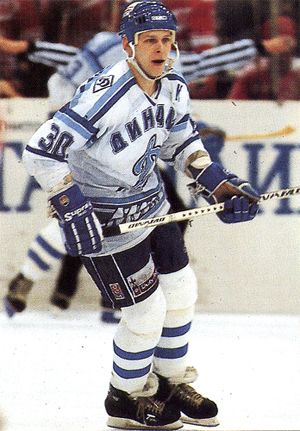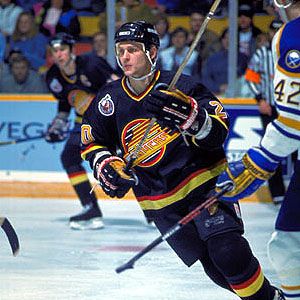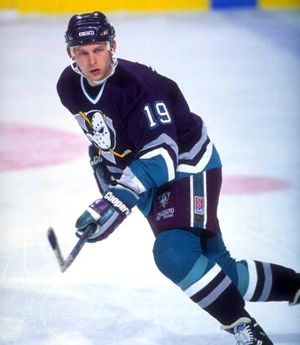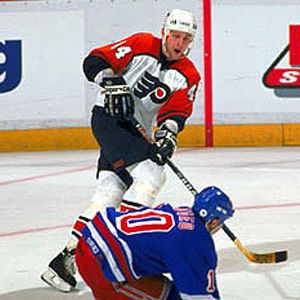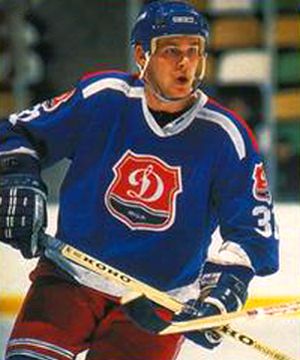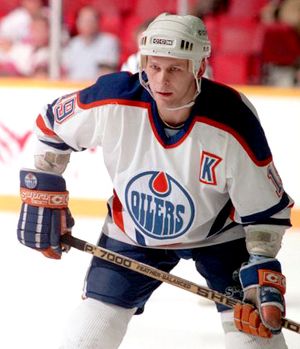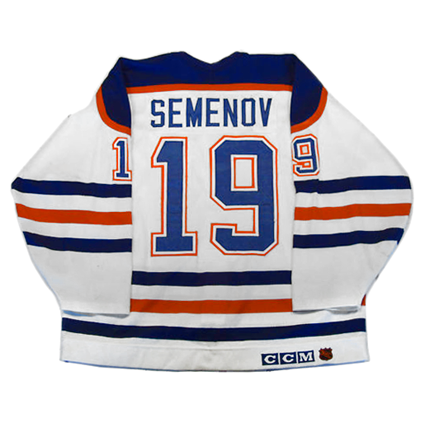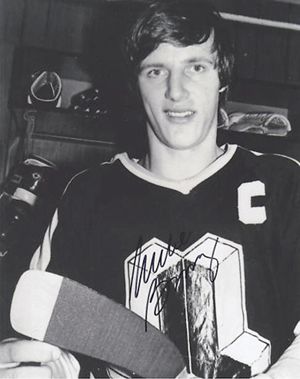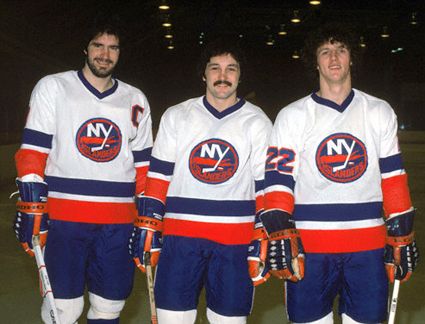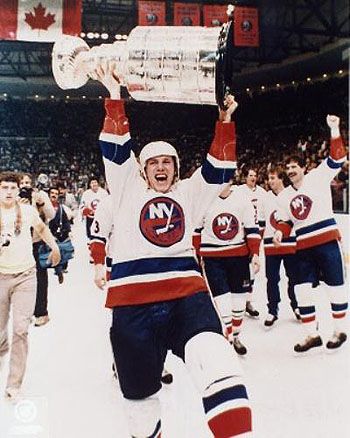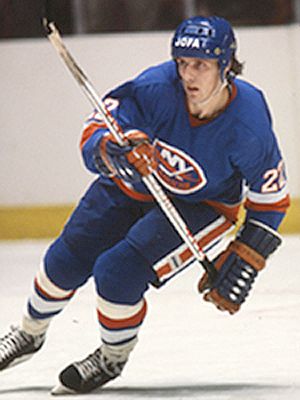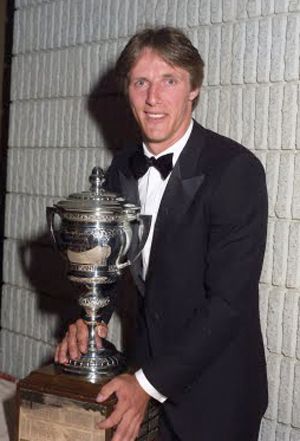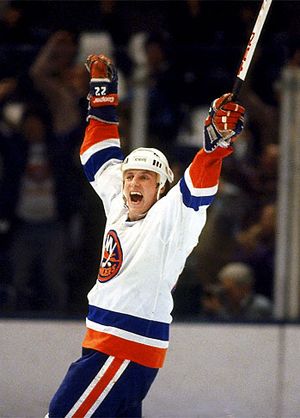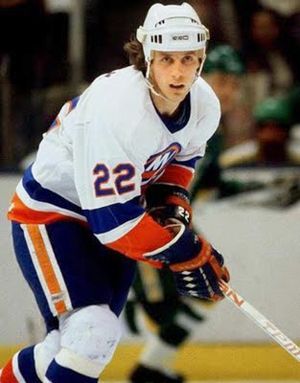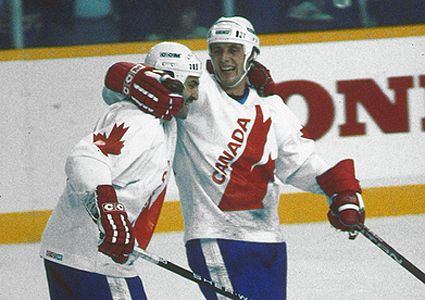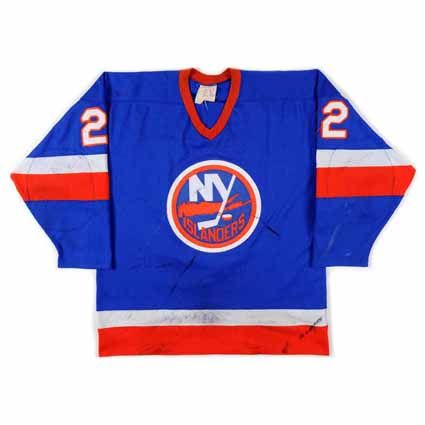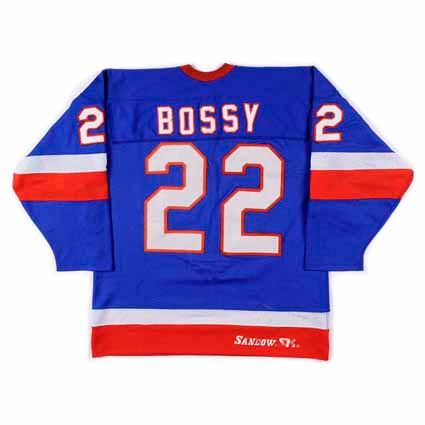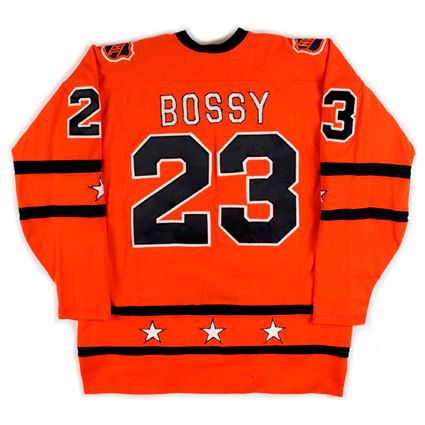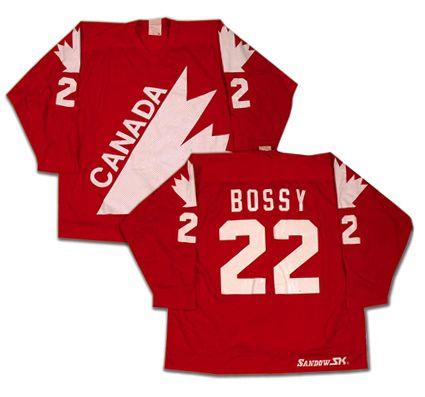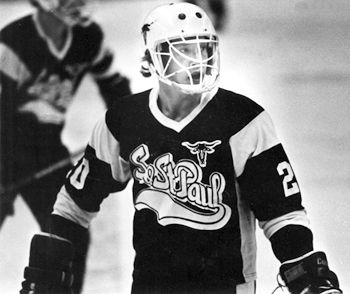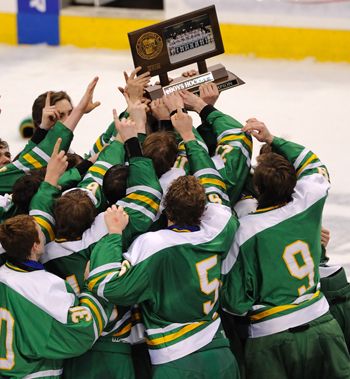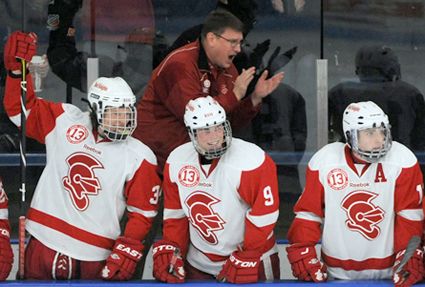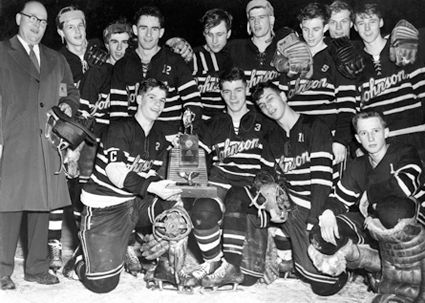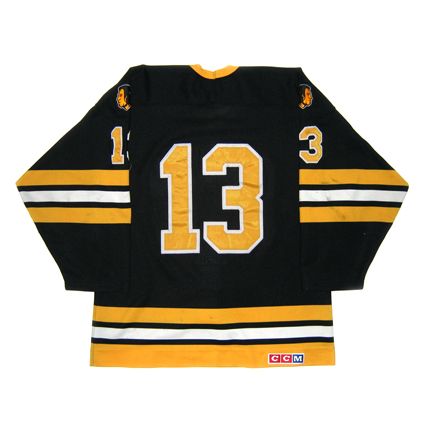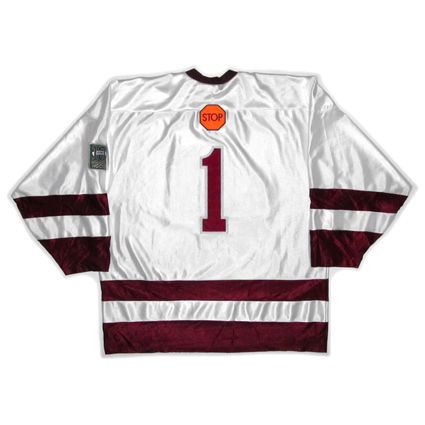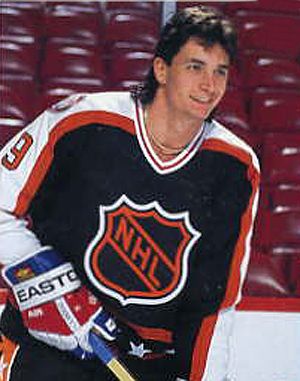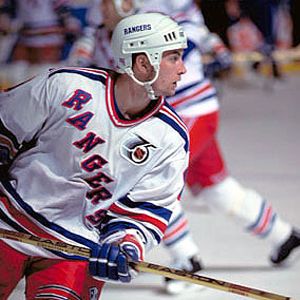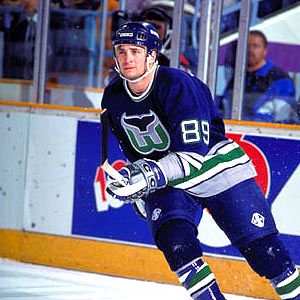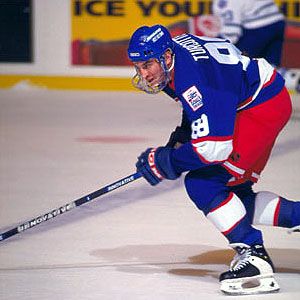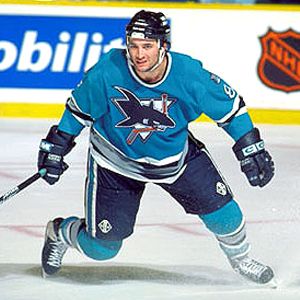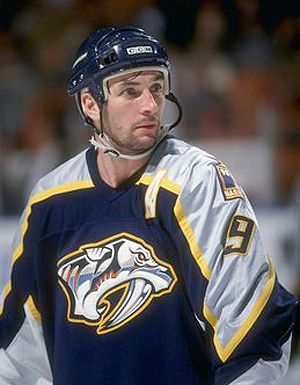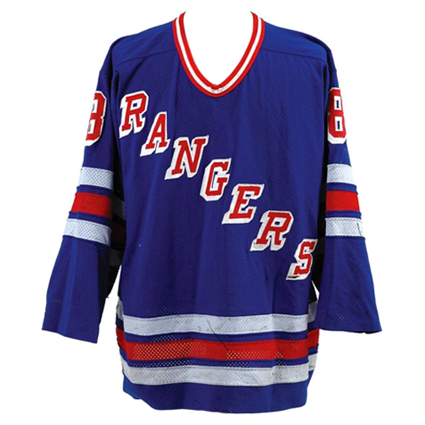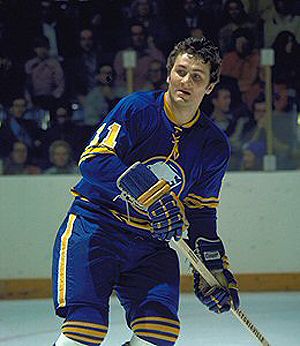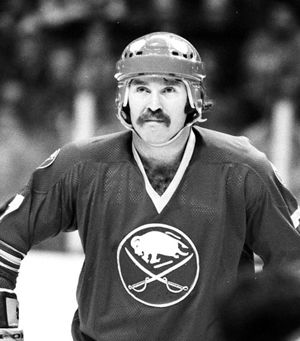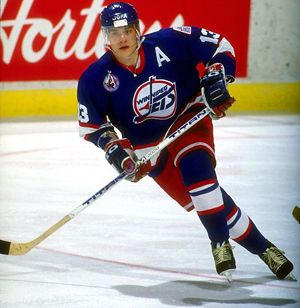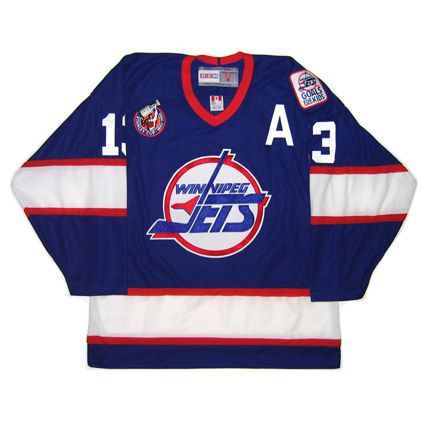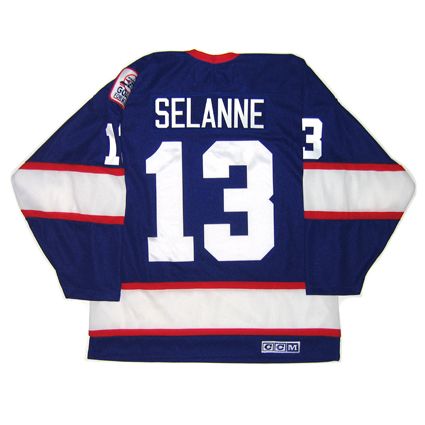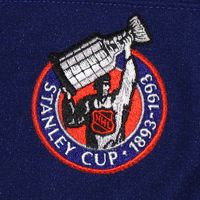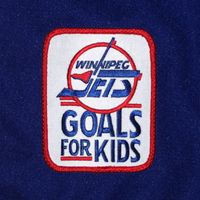Saturday, March 5, 2016
1990-91 Edmonton Oilers Anatoli Semenov Jersey
Born on this date in 1962, Anatoli Semenov was born during a generation of Soviet players who would live to have the freedom to play in North America that players born just ten years earlier would not enjoy, such as the great goaltender Vladislav Tretiak.
Semenov began is top level career with Dynamo Moscow of the Soviet Championship League back in the 1979-80, the first of 11 seasons as Dynamo's top player, which included leading them in scoring three times and being named an All-Star in 1985. His most notable seasons came in 1982-83 with 22 goals in 44 games, 1986-87 with 44 points in 40 games and his final season with Dynamo in 1989-90 when they finally wrestled the championship away from Central Red Army in 1990 following 13 straight titles for CSKA and the club's first since 1954.
Dynamo Moscow team captain Semenov
With the political situation of the Soviet Union in flux, Semenov was drafted by the Edmonton Oilers in the 1989 Entry Draft in hopes of him eventually being allowed to leave for the NHL in the not too distant future, as the veteran center was 27 years old at the time of his being drafted.
He was soon able to join the Oilers, when after Dynamo secured the 1990 championship, he arrived in Canada in time to play two playoff games with the Oilers, who would go on to win the Stanley Cup at the conclusion of the playoffs, although he did not meet the requirements to have his name engraved on the cup.
His first full season with Edmonton, Semenov saw action in 57 games and scored 31 points. Additionally, he would score another 10 points in a dozen playoff games. His offensive production took a sizable step forward as his comfort level with life and hockey in North America rose during the 1991-92 season, when in 59 games Semenov scored 20 goals and 42 points.
Not having established himself as a regular in the Oilers lineup, he was left unprotected in the 1992 Expansion Draft, which made him available to be selected by the Tampa Bay Lightning. His stay in Florida was short-lived, as, after just 13 games, he was dealt to the Vancouver Canucks who were looking for another Russian to play alongside Pavel Bure. The combination worked well, particularly in the first half of the season, which led to Semenov setting a career high with 49 points for the year.
After tailing off during the second half of the season, he was once again left unprotected for another expansion draft, this time being chosen by the Mighty Ducks of Anaheim for their inaugural season of 1992-93. Once again he was hard pressed to play every night, and finished the season with just 49 games and 30 points.
He began the 1994-95 season with the Mighty Ducks, but after just 15 games, he was traded to the Philadelphia Flyers, with whom he played 26 games in the regular season and 15 in the postseason.
The 1995-96 season was a mirror image of the previous one, as he began the season with the Flyers, who traded him back to the Mighty Ducks. His final NHL season saw him sign with the Buffalo Sabres, with whom he played 25 games before retiring after 362 games, 68 goals and 126 assists for 194 points.
Prior to coming to the NHL Semenov had an accomplished international career, playing for the Soviet Union National Team during the European Junior Championships in 1980, the World Junior Championships in 1981 and 1982, where he scored 5 goals and 13 points in 7 games, the 1984 and 1987 Canada Cup tournaments, Rendezvous '87 against the NHL All-Stars, the 1987 World Championships, the 1988 Olympics and joined Dynamo Riga for their Super Series tour of North America in 1988-89 in addition to his participation with Dynamo Moscow in the Super Series in 1985-86 and 1989-90, all of which made him well known to NHL clubs prior to his being drafted by the Oilers.
Semenov while with Dynamo Riga during the Super Series '89
Today's featured jersey is a 1989-90 Edmonton Oilers Anatoli Smeneov jersey, which unusually features a captain's "K". The story behind the Cyrillic "K" being used to designate the team's captain on Semenov's jersey in place of the standard Latin "C" was that the Oilers were scheduled to play a game versus the Soviet Central Red Army team as part of the 1990-91 Super Series against one of the touring Soviet teams on January 6, 1991 and regular Oilers team captain Mark Messier opted to sit out the exhibition contest in order to rest his sore leg, leaving the Oilers without a captain.
The team then held a vote and elected Semenov their honorary captain for the day against many of his former national team teammates. It was at this point that the Oilers equipment staff, possessing a sense of history and fun, made a "K" for Semenov's jersey to be worn that night and glued it onto his jersey, creating one of the most unique jerseys in the long history of the NHL.
The jersey itself is the standard Oilers jersey of the era, first worn when they became members of the NHL in 1979 and used through the 1995-96 season with only a few minor variations, mainly in the fonts used for the numbers the first two seasons, and it's best known for being the jersey worn for five Stanley Cup championships.
Here is Semenov scoring against the NHL All-Stars during Rendez Vous '87 for the Soviet Union and paying the price with his body after being tripped.
Labels:
Edmonton Oilers,
Semenov Anatoli
Friday, March 4, 2016
1981-82 New York Islanders Mike Bossy Jersey
Mike Bossy had a prolific junior hockey career for the Laval National, with whom he played for five seasons, beginning with 4 appearances in 1972-73. Playing a full season in 1973-74, he reeled off a 70 goal, 118 point season in 68 games.
He kept his foot on the gas the following year, topping that with an impressive 84 goals and 149 points in 67 games, 2.22 points per games. In the post season, his torrid pace continued with 38 more points in 16 games. Over the next two seasons he would add 79 goals and 136 points followed by another 75 goals and 126 points to set the all-time QMJHL record with 309 career goals, a mark which still stands today and ranks 28 goals higher that the next closest pursuer.
Bossy with Laval
Thought of as being too timid by NHL scouts, Bossy was not chosen until 15th overall in the 1977 NHL Amateur Draft, which included being passed over by the New York Rangers and Toronto Maple Leafs not once, but twice.
Playing on a line with Bryan Trottier and Clark Gillies, Bossy would set the hockey world on fire when he scored 53 goals in his rookie season of 1977-78, the first rookie to ever reach 50, while winning the Calder Trophy in the process.
The line of Gillies, Trottier and Bossy
The following season of 1978-79 he would better that by becoming only the second player after Maurice Richard, and first in 36 years, to score 50 goals in 50 games. Bossy did it in dramatic style with two goals in the last five minutes of game number 50. He would finish the season with 69 goals to lead the league and 57 assists for 126 points, good for fourth overall.
Bossy poses with Maurice Richard to
commemorate their 50 goals in 50 games
commemorate their 50 goals in 50 games
1979-80 would see Bossy once more top the 50 mark with 51 goals in 75 games and the Islanders would capture their first of four consecutive Stanley Cup Championships as Bossy contributed 23 points in just 16 playoff games.
While topping 50 goals the previous season, he did fail to reach 100 points during the regular season. Over the course of the next six seasons from 1980-81 through 1985-86, he would blow past the 100 point level, never scoring less than 117, with a high of 147 in 1981-82.
Bossy holding one of the four Stanley Cups he would win with the Islanders
During the 1980-81 season he would set a career high in goals with 68, which included becoming the fastest player to ever reach 250 goals. His 68 goals once again led the NHL and he added a remarkable 17 goals and 35 points in 18 playoff games as the Islanders would capture their second straight Stanley Cup.
On this date during the 1981-82 season, Bossy became the first player in NHL history to score 50 goals in each of his first five seasons as the Islanders blasted the Toronto Maple Leafs 10-1. He would finish the season with 64 goals and a career high 147 points, good for second overall in the league.
The Islanders would conclude the season with their third Stanley Cup Championship which would see Bossy recognized with the Conn Smythe Trophy as playoff MVP following 17 goals and 27 points in 19 games.
The Islanders would conclude the season with their third Stanley Cup Championship which would see Bossy recognized with the Conn Smythe Trophy as playoff MVP following 17 goals and 27 points in 19 games.
Bossy won the Conn Smythe in as Playoff MVP in 1982
The Islanders dynasty was now in full force and Bossy once more reached 60 goals for the third straight season in 1982-83, this time on the nose with an even 60. His 118 point regular season continued his 100 point season streak and the playoffs would again see him get his now customary 17 goals (for the third year in a row and the only player to ever do so) and 26 points in 19 games. He would also be recognized for his style of play with the first of three Lady Byng Trophies following the season.
Bossy with the Lady Byng Trophy
1983-84 was another 118 point season with 51 goals scored. The Islanders would make it once more to the finals, but the dynasty would end as they were defeated by the up and coming Edmonton Oilers 4 games to 1. The Islanders 21 playoff games would see Bossy contribute 18 points. He was the recipient of his second Lady Byng Trophy after being whistled for just 8 penalty minutes for the entire season, the second lowest total of his career following just 6 during his rookie campaign.
His remarkable goal scoring consistency continued unabated, as 58 more would be added to his career total during a 117 point campaign in 1984-85. 10 more playoff games allowed Bossy to add another 11 points for the Islanders.
During his career, Bossy totaled 160 playoff points
Showing no signs of slowing down, Bossy would reach 61 goals, paired with 62 assists, giving him his highest point total in four seasons with 123. Also that season he became just the 20th player in league history to score 1,000th career points, which he did in grand style, registering a goal and four assists in a 7-5 win over the Washington Capitals. He would also capture this third Lady Byng Trophy in the space of four seasons.
Bossy was a three time Lady Byng winner
Now slowed by back injuries, his final season of 1986-87, Bossy appeared in 63 games and scored 38 goals and 75 points, still over a point per game, before retiring at the age of just 30.
His final career totals of 573 goals and 553 assists for 1,126 points in 752 games would give him a final career average of 1.50 points per game over his ten NHL seasons and his 160 career playoff points in 129 games were a 1.24 points per game clip.
At the time of his retirement, he held the record for most goals by a rookie and most assists and points by a right wing in a single season. He still ranks third all time in hat tricks with 39. He also reached 100 goals faster than any player in history, doing so in just 129 games. He was also the quickest at one point to 300 and 500 career goals scored.
At the time of his retirement, he held the record for most goals by a rookie and most assists and points by a right wing in a single season. He still ranks third all time in hat tricks with 39. He also reached 100 goals faster than any player in history, doing so in just 129 games. He was also the quickest at one point to 300 and 500 career goals scored.
His goals per game average of .762 in the regular season is the highest in NHL history and his playoff goals per game average of .659 is second only to Mario Lemieux.
He also still holds the NHL record for the most consecutive 50 goal seasons with nine, and shares the record with Wayne Gretzky for the most 60 goal seasons with five, despite playing 10 years less than Gretzky.
Internationally, he was a member of Team Canada in the 1981 and 1984 Canada Cup tournaments, earning a gold medal in in 1984. Due to the Islanders consistent playoff history, he was never available for World Championships duty.
Bossy celebrates with Islanders teammate
John Tonelli during the Canada Cup in 1984
John Tonelli during the Canada Cup in 1984
Bossy was inducted into the Hockey Hall of Fame in 1991 and his jersey #22 was retired by the Islanders in 1992.
Today's featured jersey is a 1981-82 New York Islanders Mike Bossy jersey as worn during the season he became the first player to ever score 50 goals during his first five seasons in the NHL.
When Bossy joined the Islanders in 1977, they had just changed from a lace-up collar to a v-neck while wearing two color names and a bolder font for the numbers. In 1978 the stripes on the blue jerseys would be unified, now with a white stripe directly above a thicker orange stripe. This would be the jersey worn for their four Stanley Cup championships, lasting through 1983-84.
In 1984-85, the names would change to one color and the font for the numbers would become narrower. This style would remain unchanged through 1995 when a change in ownership would result in the debacle that was the Islanders Fishsticks jerseys being born.
Bonus jersey: Today's bonus jersey is a 1981 NHL All-Star Game Mike Bossy jersey as worn during the third of seven All-Star Games of Bossy's career. This style had a long run before merchandising would dictate more frequent changes in All-Star jerseys. First introduced in 1973, this would be used until 1981, save for 1979 when the traditional All-Star Game was replaced by a team of NHL All-Stars taking on the Soviet Union. In all, this style was worn eight times.
Extra bonus jersey: Today's extra bonus jersey is a 1981 Team Canada Mike Bossy jersey. The minimalist style used by Canada for the Canada Cup tournaments is remarkable in it's stark simplicity, with it's single color crest and customization.
It features a bold half maple leaf on the front, which was based on the Canada Cup trophy awarded to the tournament champions. Canada would not use this style for any other international tournament, such as the World Championships, as those jerseys were subject to supplier contracts with jersey manufacturers like as Adidas, Tackla, Reebok and Nike, who supplied all the teams participating in IIHF tournaments beginning in the mid-1980's.
Here is a career retrospective of Mike Bossy, which includes his dramatic 50th goal in his 50th game in 1980.
Up next is a nice interview with Bossy as he looks back on his career and a variety of topics.
A recap of the 1980 Stanley Cup Finals is next up, showing the 1980 Lake Placid Olympics patch on the Islanders jerseys. The passion and excitement of the Islander and their fans is infectious and recommended viewing. A reminder of what it's all about.
We don't know about you, but all this writing has left us hungry. Ça, c'est du bon poulet!
Labels:
Bossy Mike,
Canada,
New York Islanders,
NHL All-Star Game
Thursday, March 3, 2016
The 2016 Minnesota State High School Boy's Hockey Tournament
The 2016 Minnesota State Boys' Hockey Tournament continues today with the start of the Class AA tournament following yesterday's Class A Quarterfinals. Class AA consists of the top 64 schools by enrollment in the state and Class A is for the remaining schools. In terms of enrollment, Class AA is roughly for schools with 1,200 students or more, with the largest of the Twin Cities suburban schools reaching enrollments of 3,000.
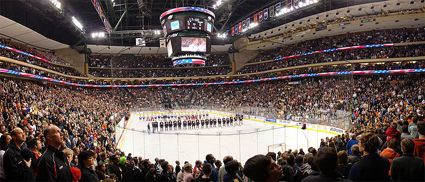
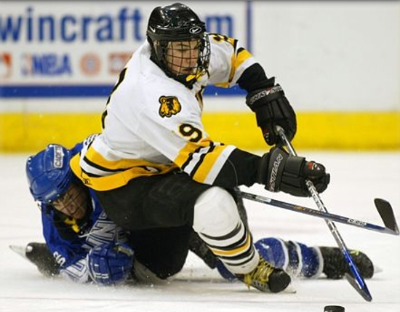
Often compared to the Indiana State Boys' Basketball Tournament or the Texas and Florida State Football Tournaments as the most important nationally for their sport, the Minnesota State Boys' Hockey Tournament is a four day festival of excitement, color and sound as the parents, relatives, fans, cheerleaders (on skates!) and bands from 16 schools all travel to the state capital of St. Paul to cheer on their teams as they compete on the ice at the home of the Minnesota Wild, the Xcel Energy Center, in front of sellout crowds of up to 19,500 fans!

Such is the stature of the tournament, that in 2014 KSTC-TV brought in no less a talent than nationally known broadcaster Gary Thorne to handle the television play-by-play duties along side Minnesota hockey legend, Lou Nanne's expert commentary, with last year being Nanne's 52nd year working the state high school tournament.
The tournament began back in 1945 in St. Paul. After a stop at the home of the Minnesota North Stars, the Met Center, for eight years in the 1970's, the tournament returned to St. Paul at the new St. Paul Civic Center, known for it's clear boards, which you can see below in one of today's videos. For nearly 50 years the tournament was played as an eight team, single class tournament, which lent itself to classic David versus Goliath matchups, as the smaller schools from the northern part of the state travelled down to the big city, taking on some of the largest schools attendance-wise in the state.
The tournament began back in 1945 in St. Paul. After a stop at the home of the Minnesota North Stars, the Met Center, for eight years in the 1970's, the tournament returned to St. Paul at the new St. Paul Civic Center, known for it's clear boards, which you can see below in one of today's videos. For nearly 50 years the tournament was played as an eight team, single class tournament, which lent itself to classic David versus Goliath matchups, as the smaller schools from the northern part of the state travelled down to the big city, taking on some of the largest schools attendance-wise in the state.
Somewhat controversially, the tournament split into two classes in 1994, based on enrollment. While schools in the smaller enrollment Class A have the option to move up and play in Class AA, the tournament lost something special in the process. Still, it is the largest state sports tournament in the United States in terms of attendance and viewership, as all the championship bracket games are broadcast on local television and 135,618 fans attending in 2015.
Despite the Xcel Energy Center having hosted NHL playoff conference finals, the 2004 NHL All-Star Game and the NCAA Frozen Four twice, with the nearby University of Minnesota winning the title in 2002 and the in-state University of Minnesota Duluth taking home the national championship in St. Paul in 2011, on March 6, 2015 21,609 fans attended the semifinals of the state tournament, setting a new record for the largest crowed to ever attend a hockey game in Minnesota, breaking the record of 19,893, which was also a session of the State High School Tournament in 2012.
Many NHL veterans have participated in the tournament, including Neal Broten, Phil Housley, Reed Larson, John Mayasich, Mike Antonovich, Henry Boucha, Mark Parrish and current NHLers T. J. Oshie of the St. Louis Blues, New York Islanders Brock Nelson and Blake Wheeler of the Winnipeg Jets. Of the 19 Minnesota players taken in the first round of the NHL Entry Draft between 2000 and 2009, 13 of them played in the state tournament.
Phil Housely of the South St. Paul Packers
Many rivalries, dynasties, villains and favorites have emerged over the years, with small schools from up north such as Eveleth, Greenway of Coleraine, International Falls and Warroad always being sentimental favorites. Roseau, in particular, has been one of the only small schools (with an enrollment of just 393 compared to 27 Twin Cities schools between 2000-3100 students, and well below the 1,300 cut-off point for Class AA status) to move up to AA and succeed with championships in 1999 and 2007.
Other schools have had their runs, with Eveleth in the late 40's/early 50's, International Falls in the 1960's, Bloomington Jefferson dominating in the early 1990's, but none more so than Edina, with 12 championships, the first coming in 1969, four in the 1970's, three in the 1980's, one in 1997 and most recently in 2014. All those titles, as well as seemingly annual tournament appearances, put the Hornets at the top of the list of "teams you love to hate", as teams from the tony Minneapolis suburb Edina are considered to be "the rich kids", even sporting green and gold jerseys in the color of money, earning the Hornets the derisive nickname the "Cake Eaters", which they annoyingly wholly embrace!
Edina celebrating one of their 12 state titles
Aside from Edina, schools on the outs with the general public are the private schools, such as The Academy of Holy Angels (champions in 2002 and 2005), Hill-Murray (1983, 1991, 2008) and most recently St. Thomas Academy (who played in the smaller Class A, winning championships in 2006, 2008, 2011, 2012 and 2013 until moving up to Class AA in 2014).
Those private schools are considered to have the advantage of being able to recruit the best players to attend their schools rather than take what comes their way in the case of the traditional public schools who draw students from their local geographic region. This "class war" is an age old argument between the public and private schools and is only magnified with the arrival of a smaller school from the north, such as when tiny Roseau makes an appearance in St. Paul, and is one of the driving forces behind the ongoing popularity of the tournament, as every great drama must have its villain.
Those private schools are considered to have the advantage of being able to recruit the best players to attend their schools rather than take what comes their way in the case of the traditional public schools who draw students from their local geographic region. This "class war" is an age old argument between the public and private schools and is only magnified with the arrival of a smaller school from the north, such as when tiny Roseau makes an appearance in St. Paul, and is one of the driving forces behind the ongoing popularity of the tournament, as every great drama must have its villain.
Since its inception, Class A has been a battle between the smaller private schools, with Benilde-St. Margaret's, St. Thomas Academy, Totino-Grace and Breck winning 12 championships and the smaller schools from the northern part of the state now given a chance to compete for a state title, with classic schools like Eveleth and International Falls able to win their first titles since the early 1970's and first time winners like Hermantown, Red Wing and four time Class A champion Warroad flying the flag for the public schools who have captured 12 titles since the two class system was introduced.
The 2012 Class AA tournament was won by Benilde-St. Margaret's, whose players all wore large patches in support of paralyzed teammate Jack Jablonski. Tied at 2-2 with less than a minute remaining in the semifinals, the Red Knights scored the game winning goal with less than 24 seconds remaining. They then stormed to the championship when Grant Besse set twitter ablaze with his five goal performance, three of which were shorthanded(!), as the Red Knights steamrolled Hill-Murray 5-1 to win an emotional championship with all thoughts on Jablonski, who was in attendance to enjoy the storybook victory that will be talked about for years to come.
Benilde-St. Margaret's players wearing
#13 patches in support of Jack Jablonski
#13 patches in support of Jack Jablonski
This year's tournament began Wednesday with the quarterfinals in Class A with #2 seeded private school Breck from the Twin Cities metro area vs Mankato West from the south central area of the state, with Breck cruising to an 8-0 win. #3 Thief River Falls from northwest area of the state faced the Princeton Tigers from north of the Twin Cities, with the Prowlers prevailing 6-1 to advance to face Breck. #1 Hermantown from just northwest of Duluth, taking on Litchfield/Dassel-Cokato from 60 miles west of the Twin Cities, with Hermantown dominating with an 11-3 win. Of note, Hermantown has lost the championship title game every year for the last six years in a row, with the first four of those being to a private school, Breck in 2010 and St. Thomas Academy in 2011, 2012 and 2013 until losing to East Grand Forks in 2014 and 2015. Finally in the nightcap, private schools #4 St. Paul Academy faced #5 ranked St. Cloud Cathedral from an hour northwest of the Twin Cities, with first time participant St. Paul Academy winning 4-2 to advance to face a very determined Hermantown.
Class AA begins today and sees a vastly different looking field than tournament regulars would expect to see. During section playoffs, upsets abounded with many of the top ranked teams falling and falling early, as #1 Benilde-St. Margaret's, #3 Minnetonka, #4 Holy Family Catholic, #5 Blaine, defending champions #7 Lakeville North, seemingly annual participant #11 Edina, #12 Elk River, #13 Duluth East, #14 St. Thomas Academy, #15 Centennial, also virtually annual participant #16 Hill-Murray all failing to make it to St. Paul this year. And of those who did make it to the State Tournament, not one of the field of eight is a private school for only the fourth time since 2000.
#2 seed Stillwater from east of the Twin Cities along the Minnesota/Wisconsin border takes on Farmington from just south of the Twin Cities. #3 Wayzata will battle Burnsville, both Twin Cities metro area suburbs. In the evening session, #1 ranked Eden Prairie from the southwest suburbs is paired against northern suburb Anoka, who are making their first appearance in St. Paul since winning the championship back in 2003. Finally, #4 Grand Rapids (enrollment 978) will square off against #5 seed Bemidji (1,144), in an unfortunate draw that will see one of the smaller schools from "up north" eliminated on the first day. With the large number of Twin Cities schools taking part, one can see why the survivor of this final game of the day will be a fan favorite for those without a rooting interest in one of the other large suburban metro area teams.
#2 seed Stillwater from east of the Twin Cities along the Minnesota/Wisconsin border takes on Farmington from just south of the Twin Cities. #3 Wayzata will battle Burnsville, both Twin Cities metro area suburbs. In the evening session, #1 ranked Eden Prairie from the southwest suburbs is paired against northern suburb Anoka, who are making their first appearance in St. Paul since winning the championship back in 2003. Finally, #4 Grand Rapids (enrollment 978) will square off against #5 seed Bemidji (1,144), in an unfortunate draw that will see one of the smaller schools from "up north" eliminated on the first day. With the large number of Twin Cities schools taking part, one can see why the survivor of this final game of the day will be a fan favorite for those without a rooting interest in one of the other large suburban metro area teams.
It's a huge deal to make it "to state" in Minnesota. This past week thousands of fans attended the eight section finals just for right to go to the state tournament, which for the kids involved means staying in a hotel in the big city, playing in an NHL arena with your buddies that you grew up with in front of all your family and friends while having your games televised live throughout the state. Many players have gone on to win national championships in college and even in the NHL, and over and over again when asked for their greatest hockey memory, the answer frequently comes back "playing in the state tournament in high school." Not necessarily winning it, just playing in it.
Once, a hockey writer quoted former three time national champion University of Minnesota and 1980 "Miracle on Ice" USA Olympic coach Herb Brooks as saying that winning a state championship with St. Paul Johnson in 1955 was one of the best moments in his career. Brooks called the writer to inform him that he had been misquoted. He said it was the best moment.
Herb Brooks, back row far right, celebrating with his St. Paul Johnson
teammates after winning the state championship in 1955
Scarlets, Mustangs, Tigers, Prowlers, Dragons, Hawks, Crusaders, Spartans, another Tigers, Ponies, Blaze, Trojans, Tornadoes, Eagles, Lumberjacks and Thunderhawks.
16 teams, 4 days, 135,000 fans, some seriously bad hair, 16 bands, 2 champions. There's nothing else quite like it.
Today's featured jersey is a 2005 Warroad Warriors Zach Larson jersey. This jersey was worn by players at Warroad High School from 2001 to half way through the 2008-09 season. Warroad won the Class A championship in 2003 and 2005 with jerseys from this set, but being a #13 jersey, there were several seasons in which no one chose the unlucky sweater number 13.
Larson defied superstition and wore this jersey during their undefeated (29-0-2) championship season of 2005, and was a teammate to current St. Louis Blues and recent United States Olympic standout Oshie, who is the all-time leading scorer in Warroad history with 104 goals and 137 assists for 241 points in just 93 games. Oshie led the entire state of Minnesota in 2004-05 with 37 goals and 100 points.

Warroad Warrior T. J. Oshie
Other notable hockey players to come from Warroad include United States Olympian Gigi Marvin, current New York Islander Brock Nelson, Dave Christian, a member of the Miracle on Ice 1980 gold medal winning USA Olympic team, who would go on to play 15 NHL seasons with Winnipeg, Washington, Boston, St. Louis and Chicago, Dave's father Bill Christian and uncle, the late Roger Christian, who won gold medals in the 1960 Olympics, and Boucha, a 1972 silver Olympic medalist who would play for Detroit, Minnesota, Kansas City and Colorado of the NHL. During it's history, no United States Olympic hockey team has ever won a medal without having a player on the team from tiny Warroad!
This is a classic looking jersey in the style and colors of the old Boston Bruins jerseys of the mid 70's to the mid 90's and is one of the few remaining schools to use a Native American nickname and imagery, while others such as Grand Rapids, Minneapolis Southwest and Burnsville all discontinued their use. The use of the Warriors name by Warroad High School is approved by the local Ojibwe band of Chippewa Indians who designed the logo used on the Warriors jerseys.
Due to the multiple years of service the jerseys often see, names on the back are seldom, if ever, worn on high school jerseys.
Bonus jersey: Today's bonus jersey is an Anoka Tornadoes jersey. While many schools create brand new logos for their teams, such as Warroad's locally designed logo, many other appropriate logos from various professional and college teams, either directly or slighly modified. This year's Section 5 champions and state tournament participant have been using the logo from the NHL's defunct Atlanta Flames for years, resisting the urge to change the flames in the center of the logo to a tornado, saving that for frequent use as their secondary shoulder logo.
2003 state champions Anoka have been home to one NHLer, Steve Alley, who played 105 games for the Birmingham Bulls of the WHA in 1977-78 and 1978-79 and 15 games for the Hartford Whalers divided between 1979-80 and 1980-81.
Let's se if we can possibly capture the event, spirit and emotion of the tournament with today's video selections, begining with a look at last years excitement.
2003 state champions Anoka have been home to one NHLer, Steve Alley, who played 105 games for the Birmingham Bulls of the WHA in 1977-78 and 1978-79 and 15 games for the Hartford Whalers divided between 1979-80 and 1980-81.
Let's se if we can possibly capture the event, spirit and emotion of the tournament with today's video selections, begining with a look at last years excitement.
Here's some classic footage from 1984 with St. Paul Johnson defeating Hill-Murray showing the unique clear boards from the St. Paul Civic Center and everyone wearing Cooperalls!
Check out the explosion of joy as Hill-Murray captures the state title in 2008 over Edina.
Wednesday, March 2, 2016
1989-90 New York Rangers Darren Turcotte Jersey
Despite being born in Boston, Massachusetts, Darren Turcotte, born on this date in 1968, took the route of Canadian junior hockey to begin his path to the NHL. He played four very consistent seasons with the North Bay Centennials of the Ontario Hockey League from 1984-85 to 1987-88, scoring between 30 and 35 goals and 63 and 78 points each season. Following his second season with the Centennials, Turcotte was selected in the sixth round by the New York Rangers in the 986 NHL Entry Draft.
He played 8 games with the Colorado Rangers if the IHL after the conclusion of his final season of junior hockey. He returned to the club, now rechristened the Denver Rangers, for the majority of the 1988-89 season and averaged more than a point per game, scoring 21 goals and 49 points in 40 games, a performance which earned him a chance to make his NHL debut with the New York Rangers. Turcotte, a center, appeared in 20 games for New York during which he scored 7 goals and 10 points.
That would be the last he would see of the minor leagues, as he made the Rangers roster right from the start of the 1989-90 season and would seize the opportunity to set a career best in his first full season with 32 goals. Turcotte would follow that with a career high 67 points in 1990-91, a season in which he appeared in the NHL All-Star Game.
1991-92 saw the second 30 goal season of his career on his way to a 53 point season, which he matched in 1992-93, his fourth consecutive season over 50 points.
His fourth season with the Rangers saw him appear in only 13 games, scoring just twice prior to a trade to the Hartford Whalers in November, for whom he would play in just 19 games in what amounted to a lost season.
He regained some of his scoring touch in the abbreviated 1994-95 season, scoring 17 times in 47 games for the Whalers.
Turcotte packed his bags once more when he was dealt to the Winnipeg Jets just prior to the 1995-96 season. His time in Winnipeg was brief however, as the Jets sent him even further west in March of the same season. In all, Turcotte would score 22 goals in 68 games on his way to 43 points.
Turcotte would play the entire 1996-97 season with the Sharks before yet another deal saw him join the St. Louis Blues for the 1997-98 campaign, a season which would conclude with Turcotte finally returning to the NHL playoffs for the first time in six seasons since leaving the Rangers.
His final two seasons were as a member of the expansion Nashville Predators. where the veteran was made an assistant captain. After being limited to 40 games in their inaugural season, a knee injury would curtail his 1999-00 season after just 9 games. Turcotte would formally retire in March of 2000 with 635 games, 195 goals and 216 assists for 411 points during his NHL career.
Internationally, Turcotte would play for the United States at the 1987 and 1988 World Junior Tournament, with 1987's 6 goals and 10 points in 7 games standing out.
He would make one additional appearance for the USA as a member of their World Championship roster in 1993, scoring twice in 6 games.
Today's featured jersey is a 1989-90 New York Rangers Darren Turcotte jersey from the season he scored a career best 32 goals.
After the Rangers returned to their diagonally crested jerseys after a brief experience with jerseys crested with their shield logo, the had, for the first time ever, put "New York" on the front of their road blue jerseys. They would return to the traditional "Rangers" cresting in 1987-88, a season before Turcotte's arrival in Manhattan.
These sweaters had the names on the back straight across for Turcotte's first two seasons before a change to the now familiar vertically arched lettering used ever since.
Bonus Jersey: Today's bonus jersey is a 1998-99 Nashville Predators Darren Turcotte jersey from the predators inaugural season. This jersey has two unique features, one being the special shoulder patches which has the year 98 noted in them and the other being the fact the jersey was produced by Bauer, while every other jersey in the league having been made by either CCM, Nike or Starter. It would be the only season the Predators jerseys were made by Bauer, as they would switch to CCM the following season.
He played 8 games with the Colorado Rangers if the IHL after the conclusion of his final season of junior hockey. He returned to the club, now rechristened the Denver Rangers, for the majority of the 1988-89 season and averaged more than a point per game, scoring 21 goals and 49 points in 40 games, a performance which earned him a chance to make his NHL debut with the New York Rangers. Turcotte, a center, appeared in 20 games for New York during which he scored 7 goals and 10 points.
That would be the last he would see of the minor leagues, as he made the Rangers roster right from the start of the 1989-90 season and would seize the opportunity to set a career best in his first full season with 32 goals. Turcotte would follow that with a career high 67 points in 1990-91, a season in which he appeared in the NHL All-Star Game.
1991-92 saw the second 30 goal season of his career on his way to a 53 point season, which he matched in 1992-93, his fourth consecutive season over 50 points.
His fourth season with the Rangers saw him appear in only 13 games, scoring just twice prior to a trade to the Hartford Whalers in November, for whom he would play in just 19 games in what amounted to a lost season.
He regained some of his scoring touch in the abbreviated 1994-95 season, scoring 17 times in 47 games for the Whalers.
Turcotte packed his bags once more when he was dealt to the Winnipeg Jets just prior to the 1995-96 season. His time in Winnipeg was brief however, as the Jets sent him even further west in March of the same season. In all, Turcotte would score 22 goals in 68 games on his way to 43 points.
Turcotte would play the entire 1996-97 season with the Sharks before yet another deal saw him join the St. Louis Blues for the 1997-98 campaign, a season which would conclude with Turcotte finally returning to the NHL playoffs for the first time in six seasons since leaving the Rangers.
His final two seasons were as a member of the expansion Nashville Predators. where the veteran was made an assistant captain. After being limited to 40 games in their inaugural season, a knee injury would curtail his 1999-00 season after just 9 games. Turcotte would formally retire in March of 2000 with 635 games, 195 goals and 216 assists for 411 points during his NHL career.
Internationally, Turcotte would play for the United States at the 1987 and 1988 World Junior Tournament, with 1987's 6 goals and 10 points in 7 games standing out.
He would make one additional appearance for the USA as a member of their World Championship roster in 1993, scoring twice in 6 games.
Today's featured jersey is a 1989-90 New York Rangers Darren Turcotte jersey from the season he scored a career best 32 goals.
After the Rangers returned to their diagonally crested jerseys after a brief experience with jerseys crested with their shield logo, the had, for the first time ever, put "New York" on the front of their road blue jerseys. They would return to the traditional "Rangers" cresting in 1987-88, a season before Turcotte's arrival in Manhattan.
These sweaters had the names on the back straight across for Turcotte's first two seasons before a change to the now familiar vertically arched lettering used ever since.
Bonus Jersey: Today's bonus jersey is a 1998-99 Nashville Predators Darren Turcotte jersey from the predators inaugural season. This jersey has two unique features, one being the special shoulder patches which has the year 98 noted in them and the other being the fact the jersey was produced by Bauer, while every other jersey in the league having been made by either CCM, Nike or Starter. It would be the only season the Predators jerseys were made by Bauer, as they would switch to CCM the following season.
Photo courtesy of Classic Auctions
In today's video section, Turcotte scores near the end of this clip on a shorthanded breakaway against the Boston Bruins. Do not adjust your screen, the picture is that snowy.
Next, Turcotte scores on a nifty play against the Winnipeg Jets Nikolai Khabibulin.
The NHL Rookie Goal Scoring Record Since 1970
During the fledgling Buffalo Sabres inaugural season of 1970-71, their first ever draft pick Gilbert Perreault scored a goal during the Sabres first ever game on October 10, 1970. He went on to lead the club in scoring that season with 38 goals and 34 assists for 72 points. Perreault's 38 goals established a new NHL rookie scoring record and earned him the 1971 Calder Trophy.
Today's video section recalls the night Selanne broke Mike Bossy's 15 year old record in front of the rabid Jets fans in Winnipeg, including his memorable celebration following the record setting goal.
Gilbert Perreault
Perreault would not hold the record long, as it would be broken the very next season by the Sabres next first round draft pick, Rick Martin. Teamed with Perreault and Rene Robert, the trio formed the explosive "French Connection" line. While Robert would not arrive until later in the season via a trade, Martin and Perreault found instant chemistry which carried throughout the entire season. With Perreault's playmaking abilities paired with a good finisher in Martin, their sats for the season were a virtual mirror image of each other, as Perreault scored 26 goals and 48 assists while Martin had an identical 74 points, but with 44 goals and 30 assists. Martin's 39th goal on February 19, 1972 broke Perreault's rookie scoring record and during the remaining 19 games, Martin raised the record to 44.
Rick Martin
Martin's record fell on February 25, 1978 when the New York Islanders first round pick in the 1977 NHL Amateur Draft, Mike Bossy, scored the 45th goal of his rookie campaign. Playing on a line with center Bryan Trottier and rugged left winger Clark Gilles, the trio finished 1-3-4 in team scoring. While Trottier led the team with 123 points, it was Bossy who benefited from Trottier's playmaking to break the rookie goal scoring record. Similar to Martin, Bossy still had 20 games remaining after breaking the record and proceeded to elevate the record up to 53, which was second in the NHL that season. Like, Perreault, Bossy was also the winner of the Calder Trophy.
Mike Bossy
Bossy's record would endure for 15 seasons, including surviving Joe Neiuwendyk's rookie total of 51 in 1987-88, until it was broken on this date in 1993 by Finnish sensation Teemu Selanne, who scored a hat trick for his his 52nd, record tying 53rd and record breaking 54th goal of the year at home against the Quebec Nordiques.
Teemu Selanne
Like those before him, Selanne was not content to simply eclipse the record. He simply destroyed Bossy's mark of 53 as he launched the record into the stratosphere with a final total of 76, which tied him for the league lead in goals with fourth year player Alexander Mogilny. Like Perreault and Bossy before him, Selanne's record setting debut season earned him the Calder Trophy.
In addition to his 76 goals, Selanne totaled 132 points to set a rookie point scoring record as well. He and Mogilny became only the second and third European players to lead the league in goals as they became members of an exclusive club of only eight men to have ever scored 70 or more goals.
To put Selanne's record shattering 1992-93 season into perspective, the closest any rookie has come in the 23 years since was Alexander Ovechkin in 2005-06 with 52 followed by Sidney Crosby that same season with 39.
To put Selanne's record shattering 1992-93 season into perspective, the closest any rookie has come in the 23 years since was Alexander Ovechkin in 2005-06 with 52 followed by Sidney Crosby that same season with 39.
Today's featured jersey is a 1992-93 Winnipeg Jets Teemu Selanne jersey. While Selanne had hoped to wear #8, it was already in use by Randy Carlyle, who would later coach Selanne in Anaheim, necessitating Selanne to wear his second choice of #13 during his rookie season. Following Carlyle's departure from Winnipeg, Selanne would switch to #8.
During the 1992-93 season, all players would wear the Stanley Cup Centennial patch on the right chest of their jerseys. Exceptions were the New York Rangers, who wore the patch on their right shoulders, and the Pittsburgh Penguins, who did not wear the patch on their new black road jerseys, both due to their diagonal cresting.
The only other oddity was that of the Winnipeg Jets. While they did wear the patch all season in the expected location, during the latter half of the season the patches worn by the Jets did not have the same bold white outline as all the other clubs.
This determination of the borderless patch being worn in the latter half of the season is corroborated by all pictures of Selanne with the assistant captain's "A", earned later in the season, being paired with the borderless patch, while early photos without the "A" have the bordered version of the patch.
The Jets would adopt a new jersey style upon entering the NHL in 1979 and wear it through 1989-90 until changing to today's featured style, which was worn through the remainder of their time in Winnipeg.
Labels:
Selanne Teemu,
Winnipeg Jets
Subscribe to:
Comments (Atom)

